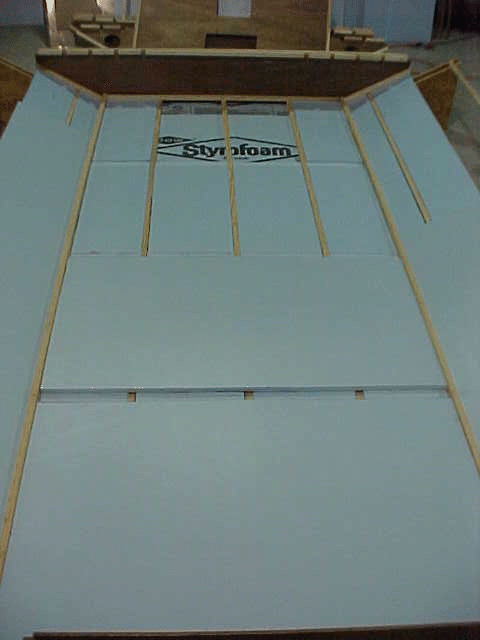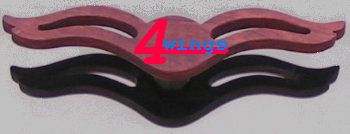| Welcome to
tips for the hull construction !
Please select your interest from the table on the left -
skirt design are in this section since you need to adjust your hull
attachment points for the final skirt in a very early stage of
construction. As well as select the appropriate skirt design before
building anything on your craft. Please hold this in mind.
If you work from plans of a designer please follow plan specs. for a
successful project.
The basics of the
lower hull:
As the lower hull of the craft we
will include the craft floor, side panels, forward and aft panels till
the top skirt attachment line. Most commercially build craft in
polyester resin ( build out of a female mold ) will use this section to
transfer to the top hull.
The lower hull :
- needs to have adequate size for
the total weight of craft and payload.
- Must be strong enough to
support craft off cushion ( on landing pads).
- Have enough freeboard to
support craft in displacement mode on water.
- Must be watertight and as
smooth as possible
In detail:
before you can start you must know
the approximate craft weight as well as payload to get an idea of your
crafts actual size. The size of the craft will be from round to
rectangular till triangular shape.
Hover pressure will be about 0.1
pound per square inch on most recreational craft.
The following table will give you a
idea of the relation between Width and Length vs Lifting Capability at 0.1 lb./ in 2.
(WFt x LFt x 144 x 0.1)
on square craft measured at GcL ( Ground contact Line ) of
skirt.
|
W / L in Feet
|
Lift in lb
|
|
3 x 5
|
216 lb
|
|
3 x 6
|
260 lb
|
|
4 x 6
|
346 lb
|
|
4 x 7
|
403 lb
|
|
4 x 8
|
461 lb
|
|
5 x 7
|
504 lb
|
|
5 x 8
|
576 lb
|
|
5 x 9
|
648 lb
|
|
6 x 10
|
864 lb
|
|
6 x 11
|
950 lb
|
|
6 x 12
|
1036 lb
|
|
7 x 12
|
1210 lb
|
|
7 x 13
|
1310 lb
|
|
7 x 14
|
1411 lb
|
|
8 x 14
|
1613 lb
|
|
8 x 15
|
1728 lb
|
|
8 x 16
|
1843 lb
|
|
8 x 17
|
1958 lb
|
|
8 x 18
|
2072 lb
|
The above numbers shall help you
to get a quick idea of the size you need for a given payload.
One of the biggest dangers
operating a Hovercraft are "plow in" ( having the nose dig in the
water or sand during high end speed cruising) and "overturn" accidents.
While overturn accidents can be mostly avoided by proper operation -
plow in has to be held in mind while building the forward section ( bow
section ) of the craft. Try to hold a boat like slope in the bow
section of the craft which can extend forward of the skirt attachment
line - this will not avoid plow in - but will make it a lot more
comfortable than with a steep bow section.
The sides of the lower hull shall
have a 15 - 30 degree angle between lower skirt attachment line and top
skirt attachment line to minimize side "plow in". Or in case of a "plow
in" to provide less damage to the skirt and a softer impact.
This will provide us more or less
with the shape of the lower hull - at this point you need
the location for the lift air as well as lift unit ( engine, duct and
prop or fan location) . Please hold in mind that the lift prop should
not be at, or below the waterline if craft is floating under maximum
payload.
Materials:
The lower hull can be build out of
all boat building materials. From simple ply to very complicated
composite panels. The lower hull is as well the section of the craft
which might get the highest abuse during operation and especially
landing in unknown areas. As long as your craft is on cushion there is
no major harm against the hull - once your lift unit fails during
operation - you can hope for a rigid floor or a soft landing.
Even if your craft has landing pads - if the center floor is nearly at
the same level as the landing pads - you will only be able to set the
craft smooth on a parking lot or water. All other surfaces will not be
leveled enough to provide a smooth surface.
In case you use composite materials -
try to use a core material which is easily available at your location.
Continuously repairing a composite panel in the manner of filling just
with resin and glass will over the years change the properties of this
panel to a brittle and heavy panel. Not to mention here the side
effects of having hard points in locations you do not need them.
We used common blue or pink
foam
before changing over to Nidacore - they have the advantage of being
easy available, reasonable enough to
build quite thick panels for good flotation and once laminated on both
sides with fiberglass in epoxy resin are chemical resistant. If a panel
is only laminated on one side it is not a composite core material.
Future damage is hard to repair and safety quite questionable.
The best place for fiberglass cloth
is not always your big supplier who is selling you off the roll for a
per yard $ - personally I prefer places like : http://thayercraft.com/ which is
your mom and pap shop and carries not only a wide variety of style and
fabric - but also the shorter length we need so often on a small to
midsize craft - feel free to check them out and compare their prices.
To increase the strength of your
floor you can encapsulate wood stringer in the center core. This will
increase your weight minimal while providing maximum strength over the
whole length of the lower hull as seen in the below picture.

3 layer of foam - center layer with
internal stringer
Once you have your hull shape you
have to select to provide inner strength to your craft by ribs ( as
well known in boat building as bulkheads) or just wooden
supports.
On a cruising Hovercraft I would
recommend that you give your hull absolute priority in aspect of
strength - after that you can be greedy on the engine aspect. If the
hull is not rigid enough to handle a certain abuse - you waste your
time and can be stuck in the middle of nowhere with a collapsed hull.
If you have length stringer in your hull or hull core panels try to
laminate the ribs to them.
Good bonding will increase impact
strength as well as the final layer of fiberglass cloth will seal
moisture out. This construction is quite time intensive but worth the
extra labor once you bump into something .... believe me there is a lot
out there.
4wings Main page - 4wings Yachtservice - Kite-sailer.com - Site-map
|

